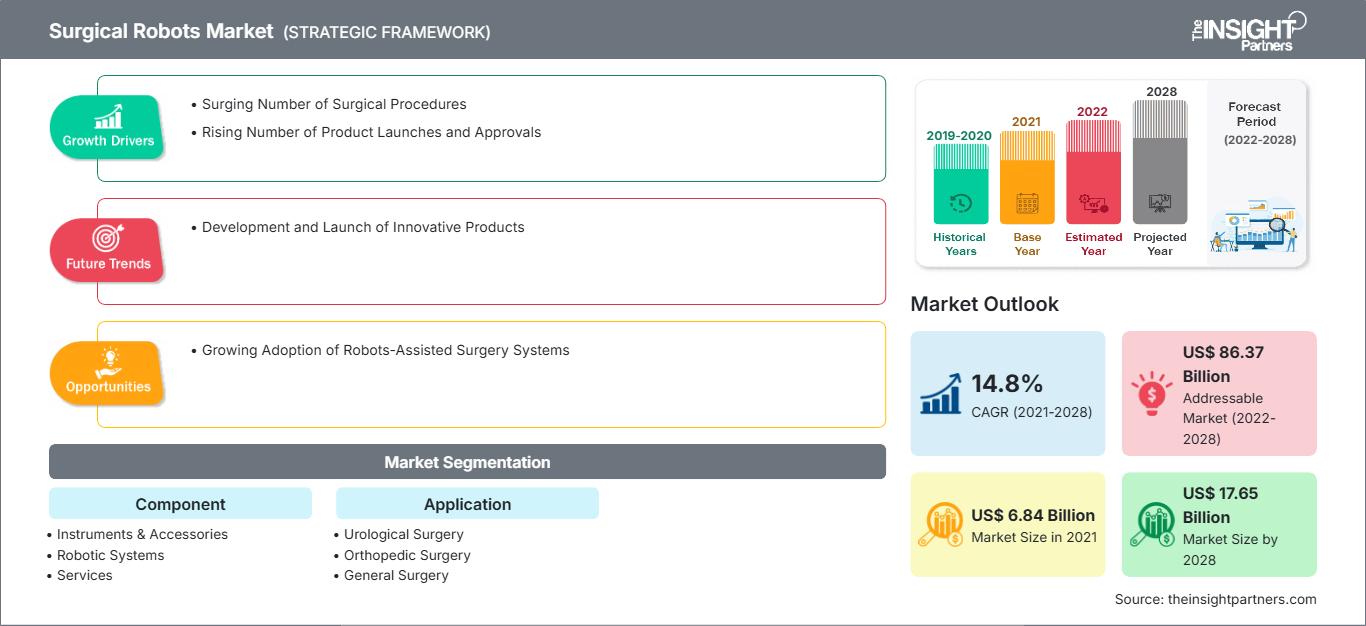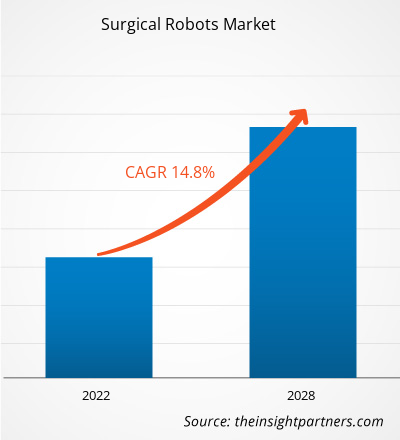[研究报告] 预计手术机器人市场规模将从 2021 年的 68.3907 亿美元增长至 2028 年的 176.4782 亿美元。预计 2022 年至 2028 年期间的复合年增长率为 14.8%。
市场洞察和分析师观点:
手术机器人用于微创手术,因为它们有助于在狭小的手术空间内操纵手术器械。这些是用于微创神经外科的微操作器。手术机器人可用于许多手术,例如泌尿外科手术、腹腔镜胆囊切除术、胆囊切除术等。手术机器人市场的范围包括组件、应用、最终用户和地域。手术机器人市场分析基于北美、欧洲、亚太地区 (APAC)、中东和非洲 (MEA) 以及南美和中美洲 (SCAM) 等主要国家。
手术数量激增以及新产品的发布和审批等关键驱动因素决定了市场的增长。例如,2023 年 2 月,Asensus Surgical 发布了其下一代手术机器人平台 Luna。这是一个新一代手术平台、器械和实时术中临床智能。其最终组件是一个受保护的云平台,利用机器学习提供临床洞察。Luna 实现了 Asensus 的绩效引导手术愿景。尖端技术通过挖掘未来几年潜力巨大的增长市场,开辟了新的业务领域和更广泛的治疗方案。
然而,高昂的手术和安装成本可能会在预测期内阻碍市场的增长。
自定义此报告以满足您的要求
您将免费获得任何报告的定制,包括本报告的部分内容,或国家级分析、Excel 数据包,以及为初创企业和大学提供超值优惠和折扣
手术机器人市场: 战略洞察

- 获取本报告的主要市场趋势。这个免费样本将包括数据分析,从市场趋势到估计和预测。
您将免费获得任何报告的定制,包括本报告的部分内容,或国家级分析、Excel 数据包,以及为初创企业和大学提供超值优惠和折扣
手术机器人市场: 战略洞察

- 获取本报告的主要市场趋势。这个免费样本将包括数据分析,从市场趋势到估计和预测。
增长动力:
外科手术数量激增推动手术机器人市场增长
全球范围内进行的外科手术数量正在增加。在过去几年中,肺癌发病率有所上升,导致需要进一步治疗。例如,在美国,肺癌是男性和女性中第二大常见癌症。根据美国癌症协会的数据,截至 2023 年,美国约有 238,340 名成年人(117,550 名男性和 120,790 名女性)被诊断出患有肺癌,约 127,070 人(67,160 名男性和 59,910 名女性)死于该疾病。肺癌占所有癌症死亡人数的五分之一,是美国癌症死亡的主要原因。这些包括小细胞肺癌和非小细胞肺癌(NSCLC)。NSCLC是最常见的肺癌类型,占所有肺癌诊断的81%。在美国,所有类型肺癌的5年相对生存率为23%,而对于NSCLC,男性和女性的5年相对生存率分别为23%和33%。在美国,建议使用螺旋计算机断层扫描(CT或CAT)扫描进行肺癌筛查。预防服务工作组(USPSTF)指出,年龄在50至80岁之间且吸烟史为20包年或以上的人群应每年进行一次低密度螺旋CT(LDCT)肺癌筛查。此外,机器人辅助肺癌手术比开胸手术具有优势,因为它需要的住院时间更短,恢复时间更快。因此,肺癌发病率的上升导致了对手术机器人的需求激增。
癌症和糖尿病是全球主要的死亡原因。 2021年,根据荷兰癌症登记处的数据,荷兰当年登记的癌症新病例约为123,672例。乳腺癌手术是整形外科最常见的手术之一。此外,根据国际糖尿病联合会 (IDF) 的数据,预计到2045年,糖尿病患者人数将从2021年的约5.37亿增长到7.83亿。
此外,机器人也用于减肥手术。因此,许多政府正在采取措施提高公众意识。例如,英国政府在2021年修订了针对接受减肥手术的肥胖患者的护理政策。这些政策包括:
- 为英格兰快速增长的肥胖人口配备国家医疗服务体系 (NHS),指导规划、评估和管理减肥患者治疗中手动操作风险所需的适当操作政策
- 设计建筑物和车辆,以安全、舒适和有尊严地容纳减肥患者。
该国的此类政府举措使人们感到舒适和安全。因此,随着越来越多的人选择这种手术,减肥手术设备市场在未来几年可能会出现显着增长。
一些市场参与者正在采用有机策略以保持市场竞争力。例如,2022 年 10 月,美敦力公司的 Hugo 机器人辅助手术 (RAS) 系统在欧洲获得了用于普通外科手术的 CE 标志。普通外科的 CE 标志涵盖多个专业,包括减肥、疝气和结直肠。因此,政府为提高人们对减肥手术的认识而采取的举措日益增多,这推动了手术机器人市场的发展。
报告细分和范围:
“手术机器人市场”根据组件、应用和最终用户进行细分。根据组件,手术机器人市场分为器械及配件、机器人系统和服务。器械及配件细分市场在 2022 年占据了市场主导地位,预计该细分市场在预测期内将达到最高增长。全球手术机器人市场的应用细分市场包括普通外科、妇科、泌尿科、骨科、介入心脏病学和神经内科等。泌尿外科手术领域在 2022 年获得了最高的市场价值。然而,妇科手术预计将在 2022 年至 2030 年期间以最高的复合年增长率增长。根据最终用户,手术机器人市场分为医院、门诊手术中心和其他市场。医院市场在 2022 年占据了主导地位。
分部分析:
按组成部分,市场分为器械及配件、机器人系统和服务。器械及配件领域在 2022 年占据了市场主导地位,预计该领域在预测期内的增长速度最快。酶类手术领域增长的主要驱动因素是审批数量的增加、功效研究的重要性以及易于获得。此外,发展中地区医疗支出的增加和手术方法的增多预计将在未来几年推动市场增长。机器人手术器械有助于提高手术过程的精准度。这些器械具备多种操作模式,可用于各种手术。例如,Intuitive Surgical 最近在市场上推出了 DaVinci Xi 的低成本版本。它的定位介于 Si 和 Xi 型号之间,而 DaVinci X 则保留了 Xi 版本更纤薄、功能更强大的机械臂和器械,并配备了 Si 型号的活动部件。DaVinci X 不仅适用于腹部手术,也适用于其他手术。DaVincisystems 为外科医生提供高清 3D 视觉、放大视图和机器人辅助。他们使用专用器械,包括微型手术摄像机和腕式器械,有助于在体内进行精确解剖和重建。因此,新兴国家越来越多地采用手术器械和配件。
市场根据应用细分为普外科、妇科、泌尿科、骨科、介入心脏病学和神经内科。泌尿外科领域在 2022 年获得了最高的市场价值。然而,妇科手术预计将在 2022 年至 2030 年间增长最快。这可能是由于全球女性妇科并发症发病率上升以及机器人系统技术的不断进步。技术进步和对微创手术的需求进一步推动了手术机器人市场的发展。
根据最终用户,手术机器人市场分为医院、门诊手术中心和其他。医院领域在 2022 年占据了最高的市场份额。机器人已成为许多医院员工队伍的重要组成部分,执行不同的专科手术,例如在 COVID-19 期间使用机器人来减少接触病原体。医院机器人正在改变早期的手术,感染几率低、精度高、并发症少。预计这些将在预测期内产生需求并促进市场增长。目前,医院正在使用各种先进的机器人,例如达芬奇手术机器人,以提高患者的护理质量和治疗效果。
区域分析 - 手术机器人市场:
根据地域划分,全球生物分析测试服务市场分为五个区域:北美、欧洲、亚太地区 (APAC)、南美和中美 (SCAM) 以及中东和非洲 (MEA)。2022 年,北美占据全球手术机器人市场的最大份额。预计亚太地区将增长更快,2022 年至 2030 年的复合年增长率最高。
北美占据手术机器人市场的最大份额。该地区的市场分为美国、加拿大和墨西哥。由于与结直肠和泌尿系统疾病相关的手术数量不断增加,该地区的市场正在增长。美国是北美乃至全球手术机器人市场最重要的贡献者。
手术机器人经常用于新生儿护理病房,以满足婴儿的特殊需求。根据《卫报》新闻传媒有限公司发表的文章,2021 年,手术机器人挽救了数百名早产儿的生命。远程医疗机器人使顾问能够进行床边视频通话,英国利物浦妇女医院和阿尔德黑儿童医院使用这种技术来治疗患病的婴儿。据美国疾病控制与预防中心称,美国的早产率有所上升,出生率从 2020 年的 10.1% 上升到 2021 年的 10.5%。在美国,早产是一个严重的健康问题,也是该国婴儿死亡的主要原因之一。由于严重的健康问题,17% 的婴儿死亡每年造成超过 250 亿美元的损失。
此外,产妇年龄增长、产前护理不佳、肥胖、人工受孕等因素也是造成早产率惊人的原因。在美国,早产最重要的风险因素之一是产妇年龄。例如,根据美国小儿麻痹症基金会的数据,2010 年至 2020 年期间,在美国,40 岁以上女性的早产率最高(14.5%),其次是 20 岁以下女性(10.4%)。此外,由于需要提供热支持才能存活,婴儿的存活变得至关重要。
此外,由于对先进产品的需求不断增长,美国手术机器人市场预计将增长,因为它们可以确保新生儿在出生时顺利分娩。此外,由于医疗保健支出不断增长,FDA 增加了新生儿护理设备的审批数量,并为医院和医疗中心提供了设备齐全的新生儿重症监护室 (NICU)。例如,美敦力于 2021 年 5 月推出了 SonarMed 气道监测系统。该系统可持续检查新生儿和婴儿的气管插管阻塞情况及其位置,为临床医生提供即时、可操作的信息。
手术机器人市场区域洞察
The Insight Partners 的分析师已详尽阐述了预测期内影响手术机器人市场的区域趋势和因素。本节还讨论了北美、欧洲、亚太地区、中东和非洲以及南美和中美洲的手术机器人市场细分和地域分布。
手术机器人市场报告范围
| 报告属性 | 细节 |
|---|---|
| 市场规模 2021 | US$ 6.84 Billion |
| 市场规模 2028 | US$ 17.65 Billion |
| 全球复合年增长率 (2021 - 2028) | 14.8% |
| 历史数据 | 2019-2020 |
| 预测期 | 2022-2028 |
| 涵盖的领域 |
By 组件
|
| 覆盖地区和国家 | 北美
|
| 市场领导者和主要公司简介 |
|
手术机器人市场参与者密度:了解其对业务动态的影响
手术机器人市场正在快速增长,这得益于终端用户需求的不断增长,而这些需求的驱动因素包括消费者偏好的演变、技术进步以及对产品优势的认知度的提升。随着需求的增长,企业正在扩展产品线,不断创新以满足消费者需求,并抓住新兴趋势,从而进一步推动市场增长。

- 获取 手术机器人市场 主要参与者概述
行业发展和未来机遇 - 手术机器人市场:
手术机器人市场领先企业采取的各种举措如下:
- 2022 年 6 月,史赛克 (Stryker) 将在印度开设先进的全球技术中心。
- 2022 年 2 月,全球医疗技术企业 Smith+Nephew 宣布在日本商业推出其下一代手持机器人平台 CORI 手术系统。
- 2021 年 11 月,Smith+Nephew 宣布推出 CORI 手持机器人,这是一款用于全膝关节和部分膝关节置换术的先进系统。
- 2022 年 8 月,骨科手术机器人创新者 THINK Surgical, Inc. 同意与韩国医疗机器人公司 Curexo, Inc. 共同开发和分销。 THINK 和 Curexo 长期以来一直保持着密切的开发合作,Curexo 负责在韩国和越南分销 THINK 的 TSolution One 平台。
竞争格局和主要公司 - 手术机器人市场:
Intuitive Surgical, Inc.;Medtronic;THINK Surgical, Inc.;Smith & Nephew;Johnson & Johnson Services, Inc.;Stryker;Siemens Healthcare GmbH;Asensus Surgical US, Inc.;Zimmer Biomet;Renishaw plc 是手术机器人市场上的佼佼者。这些公司专注于新技术、现有产品的改进和地域扩张,以满足全球日益增长的消费者需求。
- 历史分析(2 年)、基准年、预测(7 年)及复合年增长率
- PEST和SWOT分析
- 市场规模、价值/数量 - 全球、区域、国家
- 行业和竞争格局
- Excel 数据集
近期报告
相关报告
客户评价
购买理由
- 明智的决策
- 了解市场动态
- 竞争分析
- 客户洞察
- 市场预测
- 风险规避
- 战略规划
- 投资论证
- 识别新兴市场
- 优化营销策略
- 提升运营效率
- 顺应监管趋势




















 获取免费样品 - 手术机器人市场
获取免费样品 - 手术机器人市场